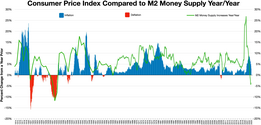
Back المدرسة النقدية Arabic Monetarizm Azerbaijani Манетарызм Byelorussian Монетаризъм Bulgarian Monetarisme Catalan Monetarismus Czech Arianyddiaeth Welsh Monetarisme Danish Monetarismus German Μονεταρισμός Greek
| Part of a series on |
| Macroeconomics |
|---|
 |
| Part of a series on |
| Capitalism |
|---|

Monetarism is a school of thought in monetary economics that emphasizes the role of policy-makers in controlling the amount of money in circulation. It gained prominence in the 1970s but was mostly abandoned as a direct guidance to monetary policy during the following decade because of the rise of inflation targeting through movements of the official interest rate.
The monetarist theory states that variations in the money supply have major influences on national output in the short run and on price levels over longer periods. Monetarists assert that the objectives of monetary policy are best met by targeting the growth rate of the money supply rather than by engaging in discretionary monetary policy.[1] Monetarism is commonly associated with neoliberalism.[2]
Monetarism is mainly associated with the work of Milton Friedman, who was an influential opponent of Keynesian economics, criticising Keynes's theory of fighting economic downturns using fiscal policy (e.g. government spending). Friedman and Anna Schwartz wrote an influential book, A Monetary History of the United States, 1867–1960, and argued that inflation is "always and everywhere a monetary phenomenon".[3]
Although opposed to the existence of the Federal Reserve,[4] Friedman advocated, given its existence, a central bank policy aimed at keeping the growth of the money supply at a rate commensurate with the growth in productivity and demand for goods. Money growth targeting was mostly abandoned by the central banks who tried it, however. Contrary to monetarist thinking, the relation between money growth and inflation proved to be far from tight. Instead, starting in the early 1990s, most major central banks turned to direct inflation targeting, relying on steering short-run interest rates as their main policy instrument.[5]: 483–485 Afterwards, monetarism was subsumed into the new neoclassical synthesis which appeared in macroeconomics around 2000.
- ^ Phillip Cagan, 1987. "Monetarism", The New Palgrave: A Dictionary of Economics, v. 3, Reprinted in John Eatwell et al. (1989), Money: The New Palgrave, pp. 195–205, 492–97.
- ^ Harvey, David (2005). A Brief History of Neoliberalism. Oxford University Press. ISBN 978-0-19-928326-2.
- ^ Friedman, Milton (2008). Monetary History of the United States, 1867-1960. Princeton University Press. ISBN 978-0691003542. OCLC 994352014.
- ^ Doherty, Brian (June 1995). "Best of Both Worlds". Reason. Retrieved 28 July 2010.
- ^ Cite error: The named reference
Blanchardwas invoked but never defined (see the help page).